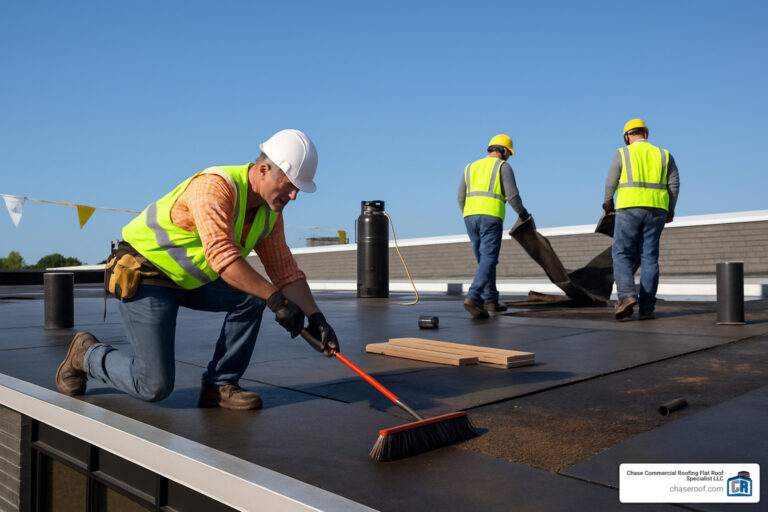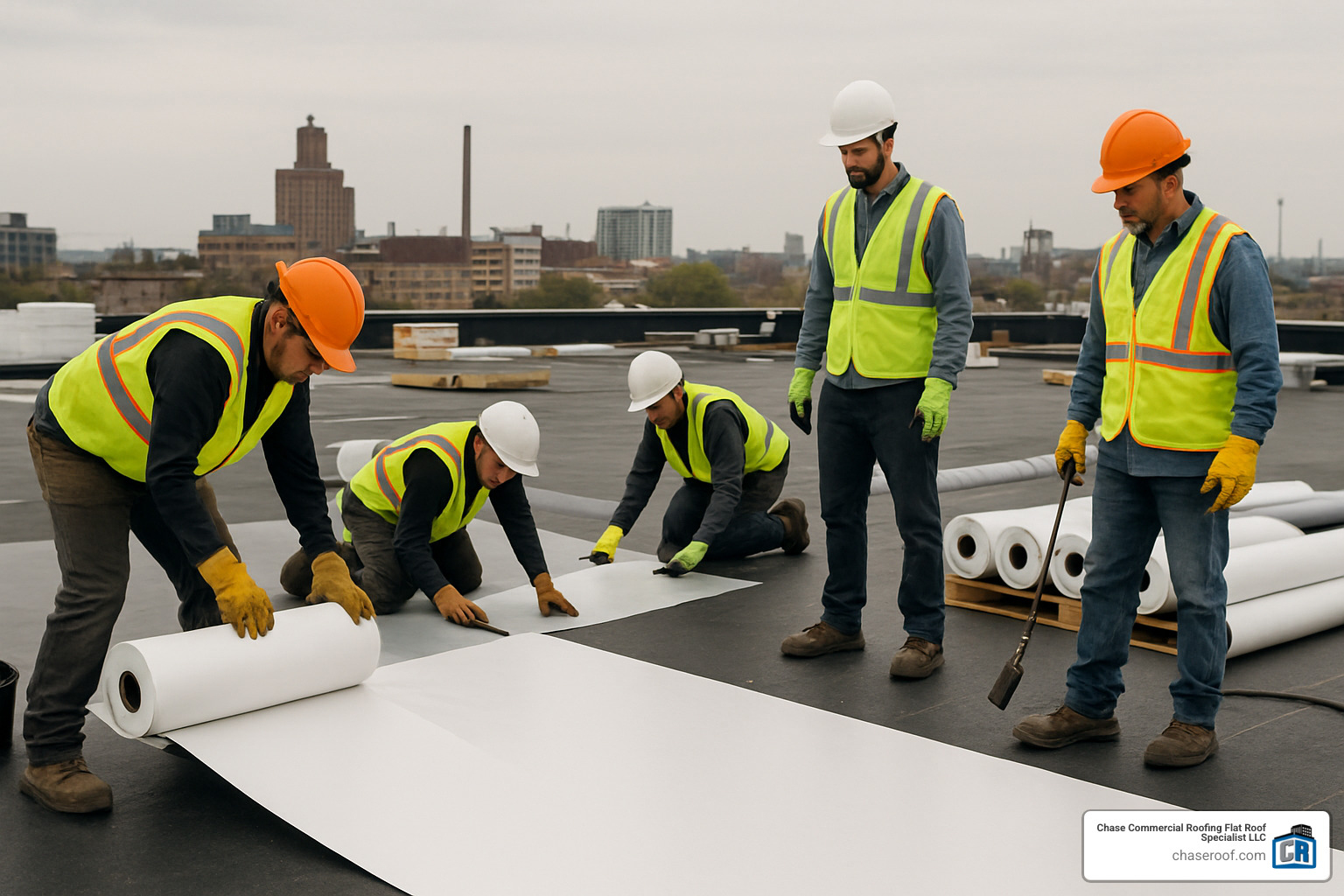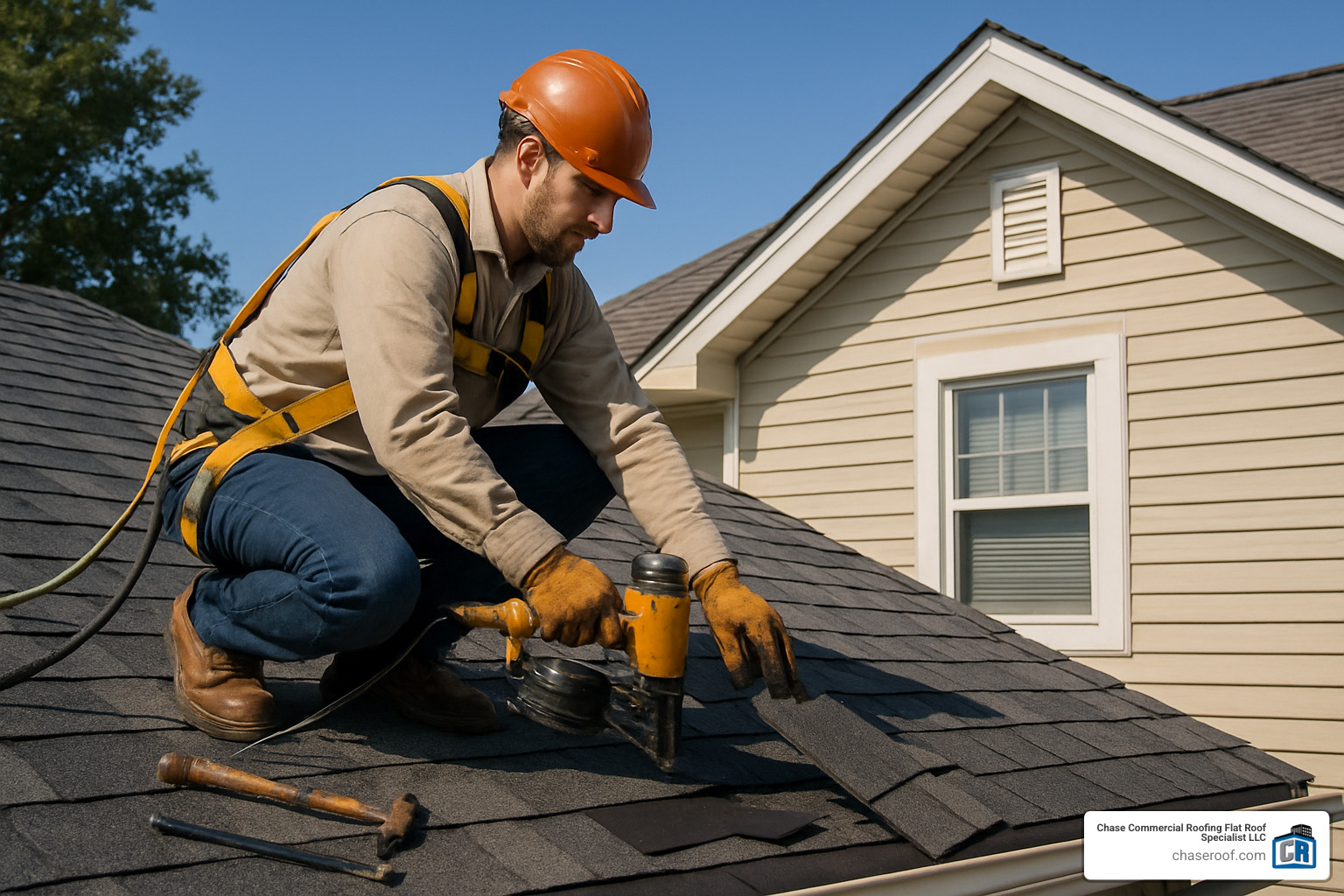Is It Time to Replace Your Flat Roof?
If you need to replace flat roof systems on your commercial building, here’s what you should know:
- Average Cost: $4-$15 per square foot, with total costs ranging from $6,000-$22,500 for an average 1,500 sq ft roof
- Materials: EPDM (40-50 year lifespan), TPO (15-30 years), PVC (20-30 years), Built-Up Roofing (15-20 years)
- Warning Signs: Leaks, water bubbles, ceiling stains, mold growth, or a roof over 15-20 years old
- Process: Tear-off, deck repair, insulation replacement, new membrane installation
- Permits: Required in most NJ municipalities, costing $250-$600 plus inspections ($120-$300)
Your flat roof takes a beating every day. From scorching summer heat to heavy winter snow, the elements constantly test its durability. When leaks appear, energy bills spike, or your roof reaches the end of its lifespan, replacement becomes inevitable. Delaying this decision often leads to more extensive damage, business disruption, and significantly higher costs.
Many commercial property owners in New Jersey struggle with the same question: patch it again or invest in a complete replacement? While repairs might seem cost-effective initially, they often mask deeper problems that continue to worsen beneath the surface.
I’m John Chase, President of Chase Commercial Roofing Flat Roof Specialist LLC with over 30 years of experience helping New Jersey businesses replace flat roof systems with durable, energy-efficient alternatives. Our team specializes in commercial flat roof replacements that minimize business disruption while maximizing long-term protection.

When to Know It’s Time to Replace a Flat Roof
Is your commercial roof trying to tell you something? The signs aren’t always as obvious as water pouring through the ceiling during a rainstorm. As New Jersey business owners, we face unique challenges with our flat roofs that require vigilance and timely action.
Let’s walk through the warning signs that indicate it’s time to replace flat roof systems before small problems become major catastrophes for your business.
Red-Flag Checklist Before You Replace Flat Roof
Those mysterious brown spots on your ceiling tiles aren’t just unsightly—they’re your roof’s cry for help. When water makes its journey from your flat roof all the way to your interior ceilings, it’s telling you something is seriously wrong up there.
Take a walk on your roof (safely, please!) and look for bubbles or blisters in the membrane. These little “roof pimples” form when moisture gets trapped between layers. While a few small blisters might be patchable, widespread bubbling suggests the whole system is failing. Think of it like rust on a car—a little spot can be fixed, but when it’s everywhere, it’s time for a replacement.
Flashing—those metal pieces around roof edges, vents, and equipment—often fails first. When you notice gaps or rust around these areas, water is likely finding its way in. Once flashing issues become widespread, it’s typically more economical to replace flat roof systems completely rather than attempting endless spot repairs.
Have you noticed a musty smell or greenery taking root on your roof? In our humid New Jersey summers, mold and vegetation thrive on consistently damp roofing materials. Beyond being unsightly, this growth accelerates deterioration and can compromise indoor air quality for your employees and customers.
If you’re on a first-name basis with our commercial roof repair team because of frequent leaks in different areas, that’s a clear signal your roof has reached retirement age. Multiple leaks mean system-wide failure is underway.
Standing water that remains on your roof more than two days after rain (known as “ponding”) is particularly troublesome. New Jersey’s freeze-thaw cycles turn these ponds into weight-bearing ice in winter, potentially causing structural concerns while accelerating membrane breakdown year-round.
Finally, check your utility bills. If heating and cooling costs are climbing without explanation, your roof’s insulation may be compromised from moisture infiltration, costing you money every month you delay replacement.

Lifespan by Material & Climate
Our Garden State weather isn’t exactly gentle on flat roofs. From sweltering summers to snow-laden winters, New Jersey’s climate creates unique challenges that affect how long your commercial roof will last.
Built-Up Roofing (BUR) systems—those traditional tar-and-gravel roofs—typically last 15-20 years in our region. If your building is near the Jersey Shore, expect the lower end of that range as salt exposure accelerates deterioration.
Modified Bitumen roofs generally provide 10-20 years of service in New Jersey. The quality of installation makes a significant difference here—properly installed self-adhered systems often outlast torch-down applications in our variable climate.
EPDM Rubber is the marathon runner of flat roofing, offering 40-50 years of protection when properly installed and maintained. Its remarkable flexibility helps it handle our dramatic temperature swings without cracking or splitting.
TPO (Thermoplastic Polyolefin) membranes typically last 15-30 years, with newer formulations performing better. The reflective white surface isn’t just trendy—it can slash your summer cooling costs by 15-30% compared to dark roofing materials.
PVC (Polyvinyl Chloride) systems provide 20-30 years of service with excellent resistance to standing water and chemical exposure—perfect for restaurants and industrial facilities throughout New Jersey.
Metal Flat Roofing offers impressive longevity at 30-50 years when properly detailed at seams and penetrations, standing up well to our heavy snow loads and summer heat.
These lifespans assume proper installation by certified professionals and regular maintenance. A roof installed by inexperienced contractors might fail in half the expected time, while a well-maintained system from Chase Commercial Roofing might exceed these estimates.
Need help determining if it’s time to replace your commercial flat roof? Our team provides free, no-obligation inspections to help you make informed decisions about your building’s most important protective system. Call us today to schedule your appointment.
Flat Roofing Materials & Costs at a Glance
When it’s time to replace flat roof systems, choosing the right material can make all the difference for your building’s protection and your budget. Let me walk you through the options we see performing best on New Jersey commercial buildings:
| Material | Cost Per Sq Ft | Lifespan | Energy Efficiency | Best For | NJ Code Compliance |
|---|---|---|---|---|---|
| EPDM | $4-$8 | 40-50 years | Good (black) to Excellent (white) | Budget-conscious projects, large roofs | Excellent |
| TPO | $6-$10 | 15-30 years | Excellent (highly reflective) | Energy-focused projects, retail | Excellent |
| PVC | $7-$12 | 20-30 years | Very Good | Restaurants, chemical exposure | Excellent |
| Built-Up Roofing | $5-$9 | 15-20 years | Fair | High-traffic roofs | Good |
| Modified Bitumen | $4-$8 | 10-20 years | Fair to Good | Moderate budgets, traditional buildings | Good |
| Metal | $10-$15 | 30-50 years | Good to Excellent | Long-term investment | Excellent |
EPDM, TPO & PVC: Modern Membranes
The roofing industry has come a long way from the days when tar and gravel were your only options. Today’s single-ply membranes offer remarkable performance that can transform your building’s protection and efficiency.
EPDM (Ethylene Propylene Diene Monomer) is like the reliable workhorse of flat roofing. We’ve installed countless EPDM roofing systems throughout New Jersey, and they just keep performing year after year. This synthetic rubber naturally flexes with your building through freezing winters and baking summers.
What makes EPDM special is its resilience – it shrugs off UV rays and comes in sheets up to 50′ x 100′, meaning fewer seams where leaks might start. At 60-mil or 90-mil thickness, it stands up to foot traffic and maintenance activities without complaint. While traditionally black, white EPDM options can significantly reduce your summer cooling costs.
TPO (Thermoplastic Polyolefin) has become our fastest-growing roofing category, and for good reason. When we install TPO roofing, we’re creating a shield that reflects heat away from your building. The hot-air welded seams form bonds actually stronger than the membrane itself – no adhesive failures here!
TPO’s bright white surface can slash cooling costs by 15-30% during New Jersey summers. It also resists mold growth and dirt accumulation, keeping your roof reflective for years. According to scientific research on thermoplastic polyolefin membranes, manufacturers continue improving these formulations, with each generation performing better than the last.
PVC (Polyvinyl Chloride) is what I recommend when a building has special needs. Restaurant owners love PVC because it resists grease and chemicals that would deteriorate other roofing types. Its fire resistance is exceptional, and it handles ponding water better than any other membrane – a real advantage on older buildings with settlement issues.
While PVC typically costs more upfront, I’ve seen these roofs perform flawlessly for decades in the harshest conditions. For buildings with specialized requirements, it’s often the wisest long-term investment.

Built-Up & Modified Bitumen: Classic Choices
Sometimes traditional approaches still have their place, especially for buildings with specific requirements or architectural considerations.
Built-Up Roofing (BUR) has been protecting buildings for over a century, and there’s something to be said for that track record. These systems layer bitumen (asphalt or coal tar) with reinforcing fabrics to create a tough, durable surface. The finished product, typically topped with gravel, stands up exceptionally well to foot traffic and mechanical abuse.
What I appreciate about BUR is its redundancy – with 3-5 waterproofing layers, a small puncture won’t lead to leaks. The gravel surface also provides excellent fire protection and shields the underlying materials from harsh UV rays. When damage does occur, repairs are straightforward and don’t require specialized equipment.
Modified Bitumen takes the BUR concept and improves it with polymer additives that improve flexibility and performance. The result is a roofing system that handles New Jersey’s temperature swings with ease. These systems come in self-adhered versions that eliminate open-flame hazards during installation – a significant safety advantage for occupied buildings.
The factory-controlled thickness ensures consistent performance across your entire roof, and some versions feature reflective granule surfaces that improve energy efficiency. Modified bitumen works well on buildings where minor structural movement might crack more rigid systems.
Green, Metal & Specialty Systems
For forward-thinking building owners looking beyond traditional options, several specialized systems deserve consideration.
Green Roof Systems transform your rooftop into a living ecosystem that provides remarkable benefits. Beyond their striking appearance, these vegetative systems provide exceptional insulation, dramatically reducing heating and cooling costs. They capture rainwater during storms, reducing runoff and helping manage stormwater requirements.
The soil and plants protect the underlying waterproofing membrane from UV damage and temperature extremes, often doubling its lifespan. While the initial investment is higher, many building owners find the long-term returns compelling, not to mention potential tax incentives and LEED certification points.
Reflective Roof Coatings offer a cost-effective way to extend your existing roof’s life while improving energy efficiency. Our roof coatings can reduce roof surface temperatures by a remarkable 50-60°F during summer heat waves. This dramatic cooling reduces thermal cycling – the expansion and contraction that eventually causes roofing failure.
Application is relatively simple with minimal disruption to your operations. For buildings with roofs in fair condition but nearing replacement age, coatings can add years of service life while improving comfort and reducing cooling costs.
Metal Flat Roofing provides exceptional longevity for commercial buildings. These systems can last 30-50 years with minimal maintenance, often outlasting the building’s ownership cycle. Their excellent fire resistance and wind uplift ratings provide peace of mind during severe weather events that are becoming more common in New Jersey.
Metal roofing is 100% recyclable at the end of its service life, and highly reflective finishes can significantly reduce cooling costs. While the initial investment is higher than membrane systems, the extended lifespan and minimal maintenance requirements typically result in the lowest lifetime cost – making metal an excellent choice for long-term property holders.
How Professionals Replace Flat Roof Systems
When you hire our team at Chase Commercial Roofing to replace flat roof systems, you’re not just getting a new membrane slapped on top of your building. You’re investing in a methodical, comprehensive approach that addresses every layer of your roofing system from the deck up.
Our professional process starts with a thorough assessment. We don’t just look at the obvious leaks – we evaluate your insulation condition, check the structural integrity of your deck, analyze drainage patterns, and ensure everything will meet current NJ building codes. This careful examination helps us design a custom solution that fits your building’s specific needs, budget constraints, and long-term performance goals.
Choosing the right materials makes all the difference in New Jersey’s challenging climate. We’ll guide you through options that make sense for your building’s use, energy efficiency targets, and budget. Then our team develops a detailed project timeline designed to minimize disruption to your daily operations – because we know your business can’t just stop while your roof gets replaced.
When installation day arrives, our certified technicians follow manufacturer specifications to the letter. This precision isn’t just about craftsmanship – it ensures your warranty remains valid and your new roof performs exactly as expected. Our commercial roof installation process leaves nothing to chance.
Should You Replace Flat Roof Yourself?
I understand the temptation to save money with a DIY approach. But flat roof replacement is one area where professional installation is almost always the smarter choice – and not just because I’m in the business!
The safety risks alone should give any building owner pause. Working at height without proper equipment is dangerous enough, but add exposure to industrial adhesives and solvents, the risk of falling through weakened decking, potential fire hazards with torch-applied systems, and proximity to power lines… suddenly that YouTube tutorial doesn’t seem so reassuring.
Even if you steer the safety challenges, performance issues almost always plague DIY commercial roofing. Improper installation leads to premature failure. Incorrect flashing details cause persistent leaks. Poor seam bonding compromises water resistance. Inadequate attachment can result in the first strong wind lifting sections of your new roof. And incorrect slope calculations leave you with ponding water that weighs down your structure.
The financial consequences can be severe too. Most manufacturer warranties become instantly void without professional installation. Your insurance company may deny claims related to an improperly installed roof. Building inspectors can issue code violations with substantial penalties. And perhaps most painful – failed DIY projects typically cost significantly more to fix than professional installation would have cost in the first place.
When roof problems become truly urgent, our emergency roof repair team provides immediate response to protect your building while proper replacement is planned.
Step-by-Step: Pro Method to Replace Flat Roof
Here’s what our professional replacement process actually looks like in action:
We begin with thorough site preparation and safety setup. This includes installing proper fall protection systems, protecting your building exterior and landscaping from damage, strategically placing debris containers, and clearly communicating the work schedule with building occupants.
The removal phase is more methodical than most people realize. We systematically tear off existing membrane and insulation, taking special care around penetrations and edge details. This gives us the opportunity to inspect your exposed deck for damage or deterioration that might have been hidden.
Deck repair is critical but often overlooked. We’ll replace any damaged sections, reinforce weak areas, thoroughly clean the surface, and verify proper slope and drainage patterns before moving forward. This foundation work prevents future problems.
Next comes the vapor barrier – a crucial component selected based on your building’s specific use. We properly seal all penetrations and terminations, integrating it carefully with wall and edge details to prevent moisture migration.
The insulation system does more than just keep your building comfortable. We install code-compliant thickness, stagger joints to prevent thermal bridging, secure everything to resist wind uplift, and add tapered systems where needed to improve drainage. Good insulation can cut your energy bills significantly.
Membrane installation is where our experience really shows. We precisely lay out materials to minimize seams, use the appropriate attachment method for your specific building (fully adhered, mechanically attached, or ballasted), and pay special attention to detail around all penetrations. We also reinforce high-stress points that are prone to future problems.
Flashing and edge details often determine whether your roof leaks or not. We install proper base and counter flashing, securely attach edge metal, create waterproof terminations at walls and parapets, and ensure everything integrates seamlessly with your building’s drainage systems.
Before we consider the job complete, we conduct a thorough quality inspection and testing. This includes visual inspection of all seams and details, electronic leak detection where appropriate, verification of proper drainage, and complete documentation of the work performed.
Finally, we leave your property as clean as we found it – removing all debris and materials, conducting a final walkthrough with you, delivering warranty documentation, and providing maintenance recommendations to maximize your roof’s lifespan.

Risks of DIY Replace Flat Roof Projects
Beyond the immediate safety concerns, DIY commercial roof replacement carries several serious risks that aren’t always obvious until it’s too late.
Permit violations catch many building owners by surprise. Most New Jersey municipalities require permits for commercial roof replacement – something DIY projects often overlook. This can result in stop-work orders right in the middle of your project, substantial fines, forced removal of non-compliant materials (even if they’re brand new), and eventually requiring professional certification of the completed work anyway.
Structural damage often occurs during DIY installations. Water infiltration into the building structure can happen through seemingly minor mistakes. Trapped moisture leads to deck deterioration over time. Excessive weight from improperly removed old roofing stresses your building’s structure. And incorrect fastening techniques can actually compromise your roof’s structural integrity.
Insurance complications are another unpleasant surprise. Many commercial insurance policies have specific requirements for roof replacement that DIY methods simply can’t meet. Non-professional installation may void your coverage entirely. Claims for water damage resulting from improper installation are routinely denied. Your premiums might increase when inspectors find non-compliant roofing. Some policies even require specific roofing systems or professional certifications.
The long-term costs of failed DIY projects almost always exceed professional installation. You’ll eventually pay for professional removal of failed materials, repairs for damage caused by leaks, business interruption during emergency fixes, and ultimately higher replacement costs due to the additional damage that occurred while water was sneaking in.
When it comes to protecting your building and everything inside it, professional installation isn’t just a luxury – it’s an investment that pays dividends through decades of reliable performance. Let our team at Chase Commercial Roofing handle your flat roof replacement with the expertise it deserves.
Flat Roof Re-Cover vs. Full Replacement
When your commercial roof starts showing signs of age, you’ll face an important decision: should you completely tear off the existing system or simply install a new one over the top? This choice impacts your budget, timeline, and long-term roof performance.
A roof re-cover means installing a new roofing membrane directly over your existing roof without removing the old materials. This approach cuts labor costs, reduces project time, and keeps business disruptions to a minimum. You’ll also save on disposal fees while maintaining the thermal value of your existing insulation – all attractive benefits for budget-conscious building owners.
On the flip side, a full replace flat roof project offers several compelling advantages. You’ll get the chance to inspect and repair the underlying deck, upgrade insulation for better energy efficiency, eliminate any trapped moisture, fix drainage problems, and end up with a lighter overall roof system. For buildings with complex issues, our commercial roof replacement services address every aspect of your roofing system from the deck up.
When a Re-Cover Makes Sense
Not every roof needs a complete tear-off. A re-cover might be your best option when:
Your roof deck is in sound condition, confirmed through core samples and professional inspection. This means the underlying structure remains solid and dry, providing a stable foundation for the new membrane.
You’re dealing with a single existing membrane, as New Jersey building codes typically only permit one re-cover over an existing system. If you’ve already re-covered once, your next project will likely require a full tear-off.
Moisture issues are limited, with professional moisture surveys showing less than 25% of the roof area contains dampness. Extensive moisture problems usually demand a complete replace flat roof project.
The existing roof provides adequate slope for water runoff, ensuring proper drainage will continue with the new membrane. Poor drainage should never be covered up with a new roof layer.
Budget constraints make immediate full replacement challenging, but you still need reliable protection. A properly executed re-cover can add 15-20 years of service life to your roof at a fraction of replacement cost.
Business continuity is paramount, and your operations simply cannot tolerate the disruption of a complete tear-off. Re-covers typically create less noise, dust, and interruption.
Why NJ Codes Often Force Full Tear-Off
Despite the cost advantages of re-covering, New Jersey building codes and local conditions often make a complete replace flat roof project mandatory:
Two-layer maximum restrictions are standard in most New Jersey municipalities. Once you’ve reached two total roofing layers, building codes require complete removal before adding another.
Drainage complications arise as each new layer raises your roof height, potentially causing problems with drainage systems, scuppers, and overflow mechanisms. Even a half-inch difference can disrupt carefully engineered water flow patterns.
Flashing height limitations become problematic when existing flashing can’t accommodate an additional roofing layer while maintaining proper termination heights. This is particularly common around parapet walls and roof penetrations.
Structural weight concerns grow with multiple roof layers. Each layer adds significant weight – potentially exceeding your building’s design limits, especially concerning in areas with heavy New Jersey snow loads.
Moisture entrapment becomes a serious issue in our Northeast climate. New Jersey’s freeze-thaw cycles make trapped moisture between layers particularly destructive, accelerating deterioration of the structure beneath.
Energy code compliance requirements have tightened significantly in recent years. Current New Jersey energy codes often mandate increased insulation values that can only be achieved with a complete tear-off and replacement.
Our experienced team at Chase Commercial Roofing can help determine whether your building qualifies for a re-cover or requires full replacement. We’ll conduct a thorough inspection, check local code requirements, and provide honest recommendations based on what’s best for your building’s long-term health – not just what generates the biggest project.
Budgeting, Permits & Picking a NJ Contractor
Planning your flat roof replacement doesn’t have to be overwhelming. With the right approach, you can steer costs, permits, and contractor selection with confidence. Let me walk you through what New Jersey commercial property owners should keep in mind.
When budgeting to replace flat roof systems, several key factors will influence your bottom line. The size and complexity of your roof plays a major role – larger roofs need more materials, though they often benefit from better pricing per square foot. The materials you choose make a significant difference too, with premium options like PVC or metal costing more upfront but potentially saving money over their longer lifespans.
For most New Jersey commercial buildings, you’ll want to budget between $4-$15 per square foot. This means a typical 1,500 square foot roof might cost anywhere from $6,000 to $22,500. That accessibility challenges like tight urban settings or complex layouts can drive up labor costs, while existing conditions requiring extensive repairs will add to your total investment.
Don’t forget about permits – they’re non-negotiable for commercial projects in New Jersey. Typical permit fees range from $250-$600, with required inspections adding another $120-$300. Your project will need to meet energy code requirements, and depending on your system, you might need structural engineering review or fire marshal approval.

Cost Factors & Money-Saving Tips
Want to keep your roof replacement affordable without sacrificing quality? Consider scheduling your project during the off-season (late fall or winter) when contractors often offer better pricing. Always get at least three detailed estimates from reputable companies to ensure competitive pricing.
Material selection deserves careful thought – while premium materials cost more initially, they often deliver better long-term value through extended lifespans and reduced maintenance costs. Don’t overlook potential energy savings either – reflective membranes like TPO can significantly reduce summer cooling costs, and some utilities offer rebates for energy-efficient roofing systems.
Smart maintenance planning can dramatically extend your roof’s life. When you replace flat roof systems, ask about maintenance programs that protect your investment. These programs often pay for themselves by preventing small issues from becoming major problems.
For a deeper dive into budgeting considerations, check out our guide on what is the average cost of a new flat roof.
Permit & Inspection Checklist
Navigating New Jersey’s permitting process requires attention to detail, especially in municipalities like Woodland Park. You’ll need a building permit application with a detailed scope of work, and for some systems, two sets of construction drawings. Be prepared to provide your contractor’s license information, insurance certificates, energy code compliance documentation, and manufacturer specifications.
The inspection process typically includes three key checkpoints: a deck inspection after tear-off, an insulation inspection before membrane installation, and a final inspection upon completion. Some systems may require additional fire marshal inspections.
Proper debris handling is strictly regulated – you’ll need proper containment during removal, documentation from a licensed disposal facility, and compliance with recycling requirements. Daily cleanup isn’t just good practice; it’s often mandated.
Working with a local contractor who understands Woodland Park’s specific requirements can make this process significantly smoother. We’ve steerd these waters countless times and can help ensure your project stays compliant from start to finish.
Choosing the Right Pro to Replace Flat Roof
The contractor you select will ultimately determine the success of your project. Start by verifying the basics: a valid New Jersey home improvement contractor license, proper liability and workers’ compensation insurance, and manufacturer certifications for your chosen materials.
Look for specialists, not generalists. Flat roofing is a distinct specialty from sloped residential roofing. A contractor with dedicated flat roof experience will understand the unique challenges and solutions your commercial building requires. Local presence matters too – a contractor with a physical location in New Jersey demonstrates stability and accessibility.
When evaluating potential contractors, dig deeper than just the estimate. Request and actually contact references from similar projects. If possible, visit completed installations to see their work firsthand. Review warranty terms carefully – what’s covered and for how long? Pay attention to how responsive and thorough they are during the estimate process, as this often reflects how they’ll handle your project.
Watch out for red flags like significantly lower bids (which often indicate corners will be cut), pressure tactics, requests for large upfront payments, vague proposals, or reluctance to provide references.
At Chase Commercial Roofing, we’re proud of our track record serving businesses throughout Woodland Park, Newark, Paterson, Jersey City, Hackensack, East Rutherford, and across New Jersey. Our transparent, professional approach has earned us the trust of commercial property owners throughout the region.
Ready to discuss your flat roof replacement? We offer free estimates and would be happy to schedule an appointment to evaluate your roof’s condition and provide expert recommendations. Our certified team specializes in commercial flat roofing systems backed by industry-leading warranties and decades of local experience.
Frequently Asked Questions about Flat Roof Replacement
How long does a new flat roof last in New Jersey?
When you invest in a new commercial roof, you want to know you’re getting your money’s worth. In New Jersey’s challenging climate, different roofing materials perform quite differently over time.
Our EPDM rubber roofs typically last an impressive 40-50 years with regular maintenance. These rubber membranes handle our freeze-thaw cycles beautifully, flexing with temperature changes rather than cracking. TPO membranes offer 15-30 years of reliable service, with the thicker 80-mil versions pushing toward the longer end of that spectrum.
For restaurant owners or buildings with chemical exposure concerns, PVC membranes deliver 20-30 years of protection with excellent resistance to ponding water – a common issue on New Jersey flat roofs after heavy rainstorms.
Traditional built-up roofing (BUR) systems typically provide 15-20 years of service in our Northeast climate, while modified bitumen systems range from 10-20 years depending on whether they’re torch-applied or self-adhered. For the ultimate in longevity, metal flat roof systems can last 30-50 years when properly detailed and maintained.
These lifespans assume proper installation and regular maintenance. The harsh New Jersey winters, hot summers, and everything in between will test your roof constantly – which is why working with experienced local specialists makes all the difference.
Can I install drainage upgrades while I replace flat roof?
Roof replacement presents the perfect opportunity to solve those annoying drainage problems once and for all! When your old roof is stripped away, we have a clean slate to implement drainage solutions that will protect your building for decades.
Tapered insulation systems are often the most transformative upgrade we install. These specially designed insulation packages create proper slope toward drains, eliminating those frustrating water puddles that never seem to dry up. For buildings with insufficient drainage points, adding new internal drains or scuppers can dramatically improve water evacuation during heavy downpours.
Many New Jersey buildings also benefit from improved overflow systems – essential safeguards that prevent structural damage during those intense summer thunderstorms when primary drains can’t keep up. Strategic placement of crickets and saddles (raised areas that direct water flow) around HVAC units and other rooftop equipment eliminates another common source of ponding water.
Even something as simple as upgrading to modern drain guards can make a significant difference, preventing clogging while still allowing proper water flow. Our design team carefully evaluates your existing drainage patterns and recommends the most cost-effective improvements to eliminate ponding water – the number one enemy of flat roofs in our region.
What warranties should I expect on a commercial flat roof?
Navigating roofing warranties can feel like reading the fine print on a car purchase, but understanding what’s covered gives you valuable peace of mind. Commercial flat roof warranties typically come in two important flavors:
Manufacturer’s Material Warranties protect you against defects in the actual roofing materials. These typically range from 10-30 years depending on the system you choose, with premium materials like PVC and EPDM offering the longest coverage periods. These warranties generally cover only the materials themselves, not the labor to replace them, and may be prorated over time. Most require documented regular maintenance to remain valid.
Contractor’s Workmanship Warranties focus on the quality of installation. At Chase Commercial Roofing, our workmanship warranties typically range from 2-10 years depending on the system installed. These cover leaks resulting from improper installation techniques – an important protection since even the best materials will fail if installed incorrectly.
For the ultimate protection, we offer access to “No Dollar Limit” (NDL) warranties through our manufacturer certifications. These premium warranties cover both materials and labor for the entire warranty period with no monetary cap on repairs. As certified installers for major manufacturers, we’re able to offer these comprehensive warranties that many contractors cannot.
When you work with our team at Chase Commercial Roofing, we’ll clearly explain all warranty options available for your specific roofing system, helping you select the coverage that makes the most sense for your building and budget. Call us today for a free estimate and comprehensive warranty information custom to your project!
Conclusion
When it’s time to replace flat roof systems on your commercial building, the decisions you make today will impact your business for decades to come. A properly installed commercial roof does more than just keep the rain out—it protects your inventory, improves energy efficiency, and provides the peace of mind that comes from knowing your business is secure from the elements.
At Chase Commercial Roofing Flat Roof Specialist LLC, we’ve spent over three decades perfecting our craft across Woodland Park, Newark, Paterson, Jersey City, Hackensack, East Rutherford, and throughout New Jersey. We’ve seen how the right roofing solution transforms businesses—eliminating those dreaded ceiling leaks, reducing energy bills, and providing decades of worry-free protection.
What makes our approach different? We believe in building relationships, not just roofs. When you work with us, you’ll experience:
- Thoughtful assessment that looks beyond surface problems to identify the true condition of your entire roofing system
- Custom solutions designed specifically for your building’s unique challenges and your business needs
- Premium materials installed by technicians who take genuine pride in their craftsmanship
- Robust warranties that actually protect your investment rather than hiding behind fine print
- Preventative maintenance programs that extend your roof’s life and maximize your return on investment
We understand that replacing your commercial flat roof represents a significant investment in your business’s future. That’s why we take the time to provide free, detailed estimates that clearly outline every aspect of your project—from the initial tear-off to the final inspection. No surprises, no hidden costs, just straightforward expertise you can trust.
For more information about our flat roof systems and how we can help your New Jersey business thrive under a reliable roof, visit our website to schedule your free roof evaluation.


Ready to protect your business with a commercial roof built to withstand New Jersey’s challenging weather? Contact us today through our website to schedule your free, no-obligation estimate. Our team of certified flat roof specialists is ready to help you steer the replacement process with confidence. We’ll help you select the right system, handle all permitting requirements, and install your new roof with minimal disruption to your daily operations.







